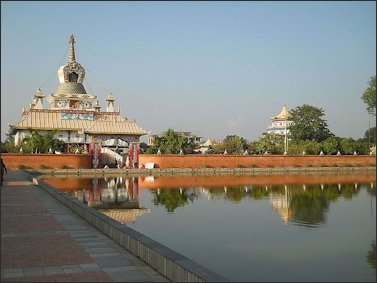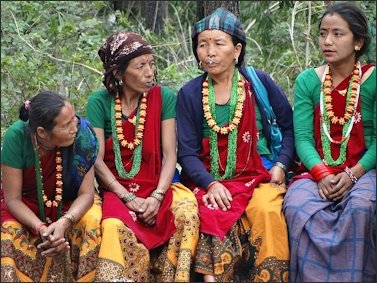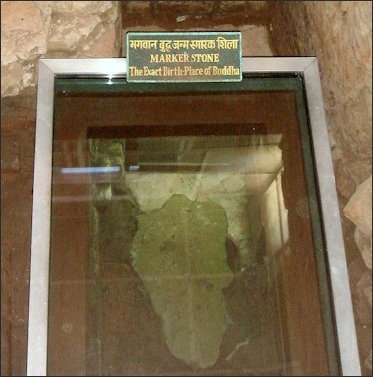LUMBINI, THE BIRTHPLACE OF THE BUDDHA

Baby Buddha
Lumbini (in southern Nepal near the Indian border) is where tradition says The Buddha, Siddhartha Guatama, was born in 623 B.C. He was a prince in Shakya clan, a people who still reside in this part of Nepal today along what are mostly Hindus and Muslims. There are no records from the seventh century B.C. that prove unequivocally that Buddha was born here but according to Buddhist lore, his parents lived 30 kilometers away in Kapilavastu. One day his mother, Queen Mahamaya, stopped here to rest while on her way to her parents home in another kingdom and suddenly gave birth to Siddhartha underneath a sal tree. Across the border in Bihar, India, in Bodh Gaya and Sarnath, is where Siddhartha achieved enlightenment and became the Buddha and delivered his first sermon.
Sights at Lumbini include Sanctum-Sanctorum of the Birthplace, Maya Devi Temple, Puskarni, The Ashokan Pillar, The Buddhist Temple, The China Temple, and the Japan Peace Stupa. The original sal tree disappeared long ago. In the early centuries after The Buddha’s death, temples were erected to mark the site where the tree is believed to have stood. But as Buddhism was replaced by Hinduism in India interest in Lumbini withered. The site was rediscovered in 1895 by the brother of the king of Nepal.
RECOMMENDED BOOKS:
“Lumbini to Kushinara: Buddha's Path” by Mrs Varsha Uke Nagpal Amazon.com ;
“Lumbini travel guide 2024: A Journey Through History And Enduring Power Of Human Belief”
by Jason S. Chapman Amazon.com ;
“Bodh Gaya” by Dr Frederick M Asher Amazon.com ;
“Buddhist Heritage Sites of India” by Sunita Dwivedi, The Dalai Lama Amazon.com ;
“The Life of the Buddha: According to the Pali Canon” by ven Bhikkhu Ñanamoli Amazon.com ;
“Siddhartha” by Herman Hesse. Amazon.com
“Twenty Jataka Tales” (Illustrated) by Noor Inayat Khan H. Willebeek Le Mair Amazon.com ;
“Buddha Stories” by Demi (1997) Amazon.com ;
“Buddhist Scriptures” by Donald Lopez (Penguin Classics) Amazon.com ;
“What the Buddha Taught” by Walpola Rahula Amazon.com ;
“In the Buddha's Words: Anthology of Discourses from the Pali Canon” with Bhikkhu Bodhi, the Dalai Lama Amazon.com ;
“The Heart of the Buddha's Teaching” by Thich Nhat Hanh Amazon.com
Buddha's Birth
According to the biographies of The Buddha, The Buddha was born fully developed in a "delightful grove, with trees of every kind, like the grove of Citraratha in Indira's Paradise" and "he did not enter the world in the usual manner, he appeared like one descending from the sky...He came out of his mother's side, without causing her pain or injury. His birth was as miraculous as that of...heroes of old who were born respectively from the thigh, from the hand, the head, or the armpit." After his birth, "with the bearing of a lion, he surveyed the four quarters, and spoke these words full of meaning for the future: 'For enlightenment I was born, for the good of all that lives. This is the last time that I have been born into this world of becoming.'" In one version the Buddha took seven steps in each cardinal direction, with lotus blossoms springing up after each step.
According to a biography of The Buddha in the Jatakas: Now other women sometimes fall short of and sometimes run over the term of ten lunar months, and then bring forth either sitting or lying down; but not so the mother of a Future Buddha. She carries the Future Buddha in her womb for just ten months, and then brings forth while standing up. This is a characteristic of the mother of a Future Buddha. So also queen Maha-Maya carried the Future Buddha in her womb, as it were oil in a vessel, for ten months; and being then far gone with child, she grew desirous of going home to her relatives, and said to king Suddhodana, [Source: Translated from the Introduction to the Jataka (i.4721), Internet Indian History Sourcebook sourcebooks.fordham.edu]
See Birth of Buddha Under STORY OF GAUTAMA SIDDHARTHA: THE BUDDHA'S EARLY LIFE BEFORE ENLIGHTENMENT factsanddetails.com
Lumbini

Lumbini
Not surprising Lumbini is a popular destination with Buddhist pilgrims from all over the world. The main attraction is the sacred garden, which features a temple depicting the birth of the Buddha, Ashoka's pillar (placed by the Indian emperor on the place where Buddha was born), and a pond where it is said Buddha's mother took a dip before she gave birth. Around the site are remnants of monasteries and chaityas (Buddhist shrines or prayer halls with a stupa at one end) built over the centuries.
Three square miles of land around Lumbini is currently being developed into a major Buddhist center. A new library and museum were opened up in 1994. A dozen monasteries paid for by various Buddhist sects have been completed in recent decades or are under construction. Two old temples — one built by Tibetan Buddhists and another built by Theravada Buddhists from Thailand, Burma and Sri Lanka — had to be moved to make way for the new buildings.
Lumbini is twelve miles away from Bhairahawa, a town that can be reached from Kathmandu by air. Thousands of monks and other worshipers have come to Lumbini to participate in the World Buddhist Conference.
Buddha tradition says Guatama lived in Kapilavastu until he was 29. Historians and archeologists have long wondered about the exact location of Kapilavastu and argued over whether it was in India or Nepal. In the early 2000s, archeologists found evidence that it was situated near the modern Nepalese town of Tilaurakot. The evidence includs a fortress wall and many building, which make it the only large urban area in Budhha's time. In 1972 a coin was found that said: "Here is the monastery of the monk of Kapilavastur.”
Archaeology in Lumbini and Discover of The Buddha’s Birthplace
Early in the 20th century the ruins of the temples were covered with an ugly cement platform. The sereneness of the site has been further disrupted by archeologists searching for remnants of the original sal tree, the first temple and the "flawless stone" placed here by the Indian Emperor Ashoka in 249 B.C. In 1996, archeologist claimed they had discovered the "flawless stone" but to find it they tore down a temple dedicated to Buddha's mother and damaged a sacred sal tree like the one Buddha was born under. Thus far they haven't damaged a huge bo tree grown because of its association with Buddha's enlightenment.

pilgrims in Lumbini
In 1996, a team of archaeologists sponsored by the United Nations excavated and uncovered what they declared to be the birth room or chamber of Siddhartha. This discovery resolved a long-standing dispute between India and Nepal over which country could claim the Buddha's birthplace. [Source: Encyclopedia.com]
The archaeologists discovered fifteen chambers buried approximately 4.8 meters (16 feet () beneath an ancient temple that marks the site of the Buddha's birth. Among the findings was a brick platform with a memorial stone on top, dating back to 249 B.C. This was the year when Emperor Ashoka, who played a significant role in promoting the spread of Buddhism, placed a brick platform over the Buddha's birthplace. The archaeologists discovered a nearby stupa, also constructed by Ashoka, containing coins and a Buddha figurine.
In 2005, sixteen countries, including Nepal, Japan, India, Pakistan, Sri Lanka, Bangladesh, Indonesia, Korea, Singapore, and Thailand, agreed to create a World Peace City in Lumbini.
Lumbini, a UNESCO World Heritage Site
According to UNESCO: “Siddhartha Gautama, the Lord Buddha, was born in 623 B.C. in the famous gardens of Lumbini, which soon became a place of pilgrimage. Among the pilgrims was the Indian emperor Ashoka, who erected one of his commemorative pillars there. The site is now being developed as a Buddhist pilgrimage centre, where the archaeological remains associated with the birth of the Lord Buddha form a central feature. [Source: UNESCO]
“The Lord Buddha was born in 623 BC in the sacred area of Lumbini located in the Terai plains of southern Nepal, testified by the inscription on the pillar erected by the Mauryan Emperor Asoka in 249 BC. Lumbini is one of the holiest places of one of the world's great religions, and its remains contain important evidence about the nature of Buddhist pilgrimage centres from as early as the 3rd century BC.
“The complex of structures within the archaeological conservation area includes the Shakya Tank; the remains within the Maya Devi Temple consisting of brick structures in a cross-wall system dating from the 3rd century BC to the present century and the sandstone Ashoka pillar with its Pali inscription in Brahmi script. Additionally there are the excavated remains of Buddhist viharas (monasteries) of the 3rd century BC to the 5th century AD and the remains of Buddhist stupas (memorial shrines) from the 3rd century BC to the 15th century AD. The site is now being developed as a Buddhist pilgrimage centre, where the archaeological remains associated with the birth of the Lord Buddha form a central feature.”

excavated buildings in Lumbini
The site was selected as a UNESCO World Heritage Site because: 1) “As the birthplace of the Lord Buddha, testified by the inscription on the Asoka pillar, the sacred area in Lumbini is one of the most holy and significant places for one of the world’s great religions”; and 2) “The archaeological remains of the Buddhist viharas (monasteries) and stupas (memorial shrines) from the 3rd century BC to the 15th century AD, provide important evidence about the nature of Buddhist pilgrimage centres from a very early period.” “The integrity of Lumbini has been achieved by means of preserving the archaeological remains within the property boundary that give the property its Outstanding Universal Value. The significant attributes and elements of the property have been preserved. The buffer zone gives the property a further layer of protection. Further excavations of potential archaeological sites and appropriate protection of the archaeological remains are a high priority for the integrity of the property. The property boundary however does not include the entire archaeological site and various parts are found in the buffer zone. The entire property including the buffer zone is owned by the Government of Nepal and is being managed by the Lumbini Development Trust and therefore there is little threat of development or neglect. However the effects of industrial development in the region have been identified as a threat to the integrity of the property.
“The authenticity of the archaeological remains within the boundaries has been confirmed through a series of excavations since the discovery of the Asoka pillar in 1896. The remains of viharas, stupas and numerous layers of brick structures from the 3rd century BC to the present century at the site of the Maya Devi Temple are proof of Lumbini having been a centre of pilgrimage from early times. The archaeological remains require active conservation and monitoring to ensure that the impact of natural degradation, influence of humidity and the impact of the visitors are kept under control. The property continues to express its Outstanding Universal Value through its archaeological remains. The delicate balance must be maintained between conserving the archaeological vestiges of the property while providing for the pilgrims. Protection and management requirements.
“The property site is protected by the Ancient Monument Preservation Act 1956. The site management is carried out by the Lumbini Development Trust, an autonomous and non-profit making organization. The entire property is owned by the Government of Nepal. The property falls within the centre of the Master Plan area, the planning of which was initiated together with the United Nations and carried out by Prof. Kenzo Tange between 1972 and 1978. The long-term challenges for the protection and management of the property are to control the impact of visitors, and natural impacts including humidity and the industrial development in the region. A Management Plan is in the process of being developed to ensure the long-term safeguarding of the archaeological vestiges of the property while allowing for the property to continue being visited by pilgrims and tourists from around the world.”
World's Oldest Buddhist Shrine — Dating to the Buddha’s Time — Found in Lumbini
In 2013, archaeologists said that structure inside Mayadevi temple in Lumbini, Buddha’s birthplace, dated to the sixth century B.C. — when Buddha is believed to have been alive Associated Press reported: “Archaeologists in Nepal say they have discovered traces of a wooden structure dating from the sixth century B.C. which they believe is the world's oldest Buddhist shrine.Kosh Prasad Acharya, who worked with archaeologists from Durham University, said that the structure had been unearthed inside the sacred Mayadevi temple in Lumbini. The Buddha, also known as Siddhartha Gautama, is generally thought to have been born in about the sixth century BC at the temple site. The findings were published in the December issue of the journal Antiquity. [Source: Associated Press, November 26, 2013 )~(]
“Acharya said the traces had been date tested using radiocarbon and luminescence techniques. The archaeological team dug underneath previously known brick structures in the temple, and experts from the University of Stirling examined and collected the samples, he said. The team has been working at the site for the past three years. The site at Lumbini had been hidden under the jungle until it was excavated in 1896. )~(

the spot where The Buddha is said to have been born
“Previously, a pillar installed by the Indian emperor Ashok with inscriptions dating to the third century BC was considered to be the oldest Buddhist structure, Acharya said. "This finding further strengthens the chronology of Buddha's life and was is major news for the millions of Buddhists around the world," Acharya said. "Very little is known about the life of the Buddha, except through textual sources and oral tradition," a Durham University archaeologist, Robin Coningham, said. "Now, for the first time, we have an archaeological sequence at Lumbini that shows a building there as early as the sixth century B.C."” )~(
Coningham and his team of 40 archaeologists discovered the tree shrine while what was initially supposed to restoration work Lumbini. "It has real significance," Coningham told The Guardian. "What we have for the first time is something that puts a date on the beginning of the cult of Buddhism. That gives us a really clear social and economic context... It was a time of huge transition where traditional societies were being rocked by the emergence of cities, kings, coins and an emerging middle class. It was precisely at that time that Buddha was preaching renunciation – that wealth and belongings are not everything." [Source: Elizabeth Day, The Guardian, December 1 2013 +/+]
Elizabeth Day wrote in The Guardian: “The early years of the religion took hold before the invention of writing. As a result, different oral traditions had different dates for the Buddha's birth. This is the first concrete evidence that Buddhism existed before the time of Ashoka, an Indian emperor who enthusiastically embraced the religion in the third century BC. Legend has it that the Buddha's mother, Maya Devi, was travelling from her husband's home to that of her parents. Midway in her journey, she stopped in Lumbini and gave birth to her son while holding on to the branch of a tree. The research team believe they have found evidence of a tree in the ancient shrine beneath a thick layer of bricks. According to Coningham, it became clear that the temple, 20km from the Indian border, had been built "directly on top of the brick structure, incorporating or enshrining it". +/+
Image Sources: Wikimedia Commons
Text Sources: East Asia History Sourcebook sourcebooks.fordham.edu , “Topics in Japanese Cultural History” by Gregory Smits, Penn State University figal-sensei.org, Asia for Educators, Columbia University afe.easia.columbia, Asia Society Museum asiasocietymuseum.org , “The Essence of Buddhism” Edited by E. Haldeman-Julius, 1922, Project Gutenberg, Virtual Library Sri Lanka lankalibrary.com “World Religions” edited by Geoffrey Parrinder (Facts on File Publications, New York); “Encyclopedia of the World's Religions” edited by R.C. Zaehner (Barnes & Noble Books, 1959); “Encyclopedia of the World Cultures: Volume 5 East and Southeast Asia” edited by Paul Hockings (G.K. Hall & Company, New York, 1993); “ National Geographic, the New York Times, Washington Post, Los Angeles Times, Smithsonian magazine, Times of London, The New Yorker, Time, Newsweek, Reuters, AP, AFP, Lonely Planet Guides, Compton's Encyclopedia and various books and other publications.
Last updated January 2024
